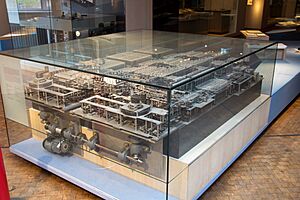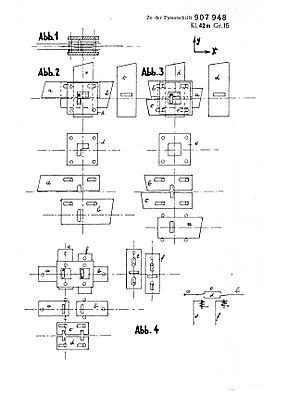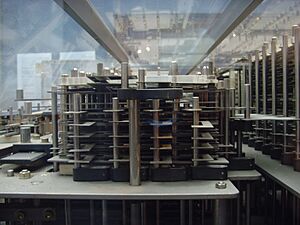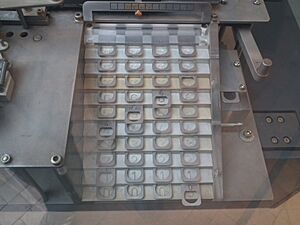Z1 (computer) facts for kids

Replica of the Z1 in the German Museum of Technology in Berlin
|
|
| Also known as | V1 (Versuchsmodell 1) |
|---|---|
| Developer | Konrad Zuse |
| Type | Programmable, binary, electrically motor-driven mechanical computer |
| Release date | 1938 |
| Retail availability | 5 years |
| Media | 35-millimeter film |
| Power | Electric motor of a vacuum cleaner |
| CPU | Ca. 30,000 metal sheets @ 1 Hz |
| Memory | Original: 16-word floating point memory Replica: 64-word floating point memory |
| Input | Keyboard, punched tape reader |
| Weight | 1 tonne (2,200 lb) |
| Successor | Z2 |
The Z1 was an early computer. It was designed by a German inventor named Konrad Zuse. He built it in his parents' home between 1936 and 1938. This machine was a mechanical calculator. It used electricity to run its parts. The Z1 could be programmed to do different tasks. It read its instructions from special punched film.
The Z1 was the first computer that could be freely programmed. It used a system called Boolean logic. This is a way of thinking about true or false statements. It also used binary floating-point numbers. These numbers are like the decimal numbers we use, but they are stored in a computer using only zeros and ones. The Z1 was finished in 1938. It was paid for entirely by private money. Sadly, the Z1 was destroyed in 1943. This happened during the World War II bombing of Berlin. All its building plans were also lost.
The Z1 was the first of many computers Zuse created. Its first name was "V1." This stood for "Versuchsmodell 1," meaning "Experimental Model 1." After World War II, it was renamed "Z1." This was to avoid confusion with the V-1 flying bombs. These bombs were designed by Robert Lusser. Later computers like the Z2 and Z3 were built using many of the Z1's ideas.
How the Z1 Was Designed
The Z1 had many parts found in modern computers. These included a control unit and memory. It also had parts for doing math. It could take information in and give results out. The Z1 was programmed using a punched tape. A special reader would read the holes in the tape.
There was a clear separation of parts. One part read the tape. Another part controlled the whole machine. A third part did the math. The input tape used 35-millimeter film. This film had holes punched into it.
The Z1 could add and subtract numbers. It worked with 22-bit floating-point values. It also had control logic. This allowed it to do more complex things. For example, it could multiply numbers by adding them many times. It could also divide by subtracting many times. The Z1 had eight different instructions it could follow. Each instruction took a different amount of time to complete.
The Z1 had a memory that could hold 16 "words." A "word" is a group of bits that the computer processes at once. Each memory word could be read or written by the control unit. Konrad Zuse patented his unique mechanical memory design in 1936. The machine could only run instructions as it read them from the punched tape. It did not load the whole program into its memory first.
Numbers were put into the Z1 in decimal form. This is the number system we use every day. The machine also gave results in decimal numbers. Special parts converted these numbers to and from binary. Binary numbers use only 0s and 1s. The program tape was a 35 mm film. Instructions were put on it using punched holes.
Building the Z1 Computer
The Z1 was a very heavy machine. It weighed about 1 tonne (2,200 pounds). It was made of about 20,000 parts. It was a programmable computer. It used binary floating-point numbers. It also had a binary switching system. The Z1 was built completely from thin metal sheets. Konrad Zuse and his friends cut these sheets using a jigsaw.
The Z1 had a keyboard for putting in information. Zuse called his programs "Rechenpläne," or "computing plans." These programs were stored on punch tapes. They used an 8-bit code.
Building the Z1 was paid for by private money. Zuse got money from his parents and his sister. Some students also helped him. Kurt Pannke, a calculating machine maker, also gave money.
Zuse built the Z1 in his parents' apartment. He was allowed to use their living room for his work. In 1936, Zuse quit his job. He had been working in airplane construction. He left to focus on building the Z1.
Zuse used thin metal strips to build the Z1. Some sources also mention metal cylinders or glass plates. The Z1 likely did not use commercial relays. Relays are electric switches. The Z3 computer, however, did use some telephone relays.
The Z1 had only one electrical part. This was an electric motor. It made the machine run at 1 Hz. This means it completed one cycle per second.
The Z1's memory was made from thin metal strips. These strips had slots and small pins. This memory was faster and smaller than relays. It was also more reliable. The Z2 computer used the Z1's mechanical memory. But its math unit used relays. The Z3 was built entirely with relays.
The Z1 was never very reliable. This was because of poor synchronization. Its mechanical parts were under stress. This caused them to not work together perfectly.
Rebuilding the Z1
The first Z1 was destroyed in 1943. This happened during the Allied air raids. But in the 1980s, Zuse decided to rebuild it. He started drawing plans for the new Z1 in 1984. With help from two engineering students, he rebuilt thousands of parts. He finished rebuilding the machine in 1989. This new Z1 has a larger memory. It has 64 words of memory instead of 16. The rebuilt Z1 is now on display. You can see it at the German Museum of Technology in Berlin.
See also
- History of computing hardware
- Analytical Engine
- Difference engine
- Z2
- Z3
- Z4






